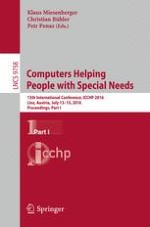2016 | OriginalPaper | Buchkapitel
Designing Effective Learning Technologies for Autistic People
verfasst von : Marion Hersh
Erschienen in: Computers Helping People with Special Needs
Aktivieren Sie unsere intelligente Suche, um passende Fachinhalte oder Patente zu finden.
Wählen Sie Textabschnitte aus um mit Künstlicher Intelligenz passenden Patente zu finden. powered by
Markieren Sie Textabschnitte, um KI-gestützt weitere passende Inhalte zu finden. powered by
